Integration of Methane Steam Reforming and Water Gas Shift Reaction in a Pd/Au/Pd-Based Catalytic Membrane Reactor for Process Intensification
Abstract
:1. Introduction
2. Methodology
2.1. Membrane Fabrication
2.2. Reaction Tests and Membrane Characterization
2.3. Mathematical Modeling Framework
- (1)
- Isothermal conditions;
- (2)
- Steady state;
- (3)
- Laminar flow;
- (4)
- Non-slip boundary condition for the fluid flow;
- (5)
- Negligible effect of the protective cage on the flow pattern.
3. Results and Discussion
3.1. He Leak Tests and H2 Permeation Tests of the Membrane
3.2. MSR in a Conventional Packed Bed Reactor: Single Catalyst
3.3. MSR/WGS in a Conventional Packed Bed Reactor: Dual Catalyst
3.4. MSR/WGS in a Catalytic Membrane Reactor
4. Conclusions
Acknowledgments
Author Contributions
Conflicts of Interest
Nomenclature
| ρ | Density of the gas mixture | kg/m3 |
| εp | Porosity of the catalytic bed | – |
| βF | Forchheimer coefficient | kg/m4 |
| Tortuosity | – | |
| d | Catalyst particle diameter | m |
| Pi | Partial pressure of component i in the reaction zone | bar |
| Péclet number | – | |
| Da | Damkohler number | – |
| ri | Reaction rate | kmol/kgcat/h |
| Ri | Rate of generation and/or destruction of component i | kmol/kgcat/h |
| ki | Reaction rate constant | varies |
| Ki | Equilibrium constant | varies |
| GHSV | Gas hourly space velocity | h−1 |
| Flux of component i | mol/s | |
| Rg | Ideal gas constant | J/K/mol |
| Hydrogen permeance of the membrane | Nm3·m−2·h−1·bar−0.5 | |
| T | Temperature | K |
| Δ | Delta index | – |
| t | Membrane’s thickness | µm |
| u | Velocity field | m/s |
| F | External body forces (gravity, electric, etc.) | N |
| I | Identity matrix | – |
| X | Conversion of methane | – |
| Binary diffusion coefficient between components A and B | cm2/s | |
| Molecular weight of component A | g/mol | |
| Collision integral for diffusion | Å | |
| σAB | Lennard–Jones potential between molecules A and B | – |
References
- U.S. Office of Energy Efficiency & Renewable Energy. Available online: http://energy.gov/eere/fuelcells/hydrogen-production-natural-gas-reforming (accessed on 1 March 2016).
- Ayturk, M.E.; Kazantzis, N.K.; Ma, Y.H. Modeling and performance assessment of Pd- and Pd/Au-based catalytic membrane reactors for hydrogen production. Energy Environ. Sci. 2009, 2, 430–438. [Google Scholar] [CrossRef]
- Guazzone, F.; Catalano, J.; Mardilovich, I.P.; Kniep, J.; Pande, S.; Wu, T.; Lambrecht, R.C.; Datta, S.; Kazantzis, N.K.; Ma, Y.H. Gas permeation field tests of composite Pd and Pd-Au membranes in actual coal derived syngas atmosphere. Int. J. Hydrog. Energy 2012, 19, 14557–14568. [Google Scholar] [CrossRef]
- Mardilovich, I.P.; Castro-Dominguez, B.; Kazantzis, N.K.; Wu, T.; Ma, Y.H. A comprehensive performance assessment study of pilot-scale Pd and Pd/alloy membranes under extended coal-derived syngas atmosphere testing. Int. J. Hydrog. Energy 2015, 40, 6107–6117. [Google Scholar] [CrossRef]
- Dixon, A.G. Recent research in catalytic inorganic membrane reactors. Int. J. Chem. React. Eng. 2003, 1, 1–35. [Google Scholar] [CrossRef]
- Catalano, J.; Guazzone, F.; Mardilovich, I.P.; Kazantzis, N.K.; Ma, Y.H. Hydrogen production in a large scale water-gas shift Pd-based catalytic membrane reactor. Ind. Eng. Chem. Res. 2013, 52, 1042–1055. [Google Scholar] [CrossRef]
- Patrascu, M.; Sheintuch, M. On-site pure hydrogen production by methane steam reforming in high flux membrane reactor: Experimental validation, model predictions and membrane inhibition. Chem. Eng. J. 2015, 262, 862–874. [Google Scholar] [CrossRef]
- Koc, R.; Kazantzis, N.K.; Ma, Y.H. Membrane technology embedded into IGCC plants with CO2 capture: An economic performance evaluation under uncertainty. Int. J. Greenh. Gas Control 2014, 26, 22–38. [Google Scholar] [CrossRef]
- Ma, L.-C.; Castro-Dominguez, B.; Kazantzis, N.K.; Ma, Y.H. Integration of membrane technology into hydrogen production plants with CO2 capture: An economic performance assessment study. Int. J. Greenh. Gas Control 2015, 42, 424–438. [Google Scholar] [CrossRef]
- Gallucci, F.; Paturzo, L.; Famà, A.; Basile, A. Experimental study of the methane steam reforming reaction in a dense Pd/Ag membrane reactor. Ind. Eng. Chem. Res. 2004, 43, 928–933. [Google Scholar] [CrossRef]
- Shu, J.; Grandjean, B.P.A.; Kaliaguine, S. Asymmetric Pd-Ag/stainless steel catalytic membranes for methane steam reforming. Catal. Today 1995, 25, 327–332. [Google Scholar] [CrossRef]
- Lin, Y.M.; Liu, S.L.; Chuang, C.H.; Chu, Y.T. Effect of incipient removal of hydrogen through palladium membrane on the conversion of methane steam reforming: Experimental and modeling. Catal. Today 2003, 82, 127–139. [Google Scholar] [CrossRef]
- Kikuchi, E.; Nemoto, Y.; Kajiwara, M.; Uemiya, S.; Kojima, T. Steam reforming of methane in membrane reactors: Comparison of electroless-plating and CVD membranes and catalyst packing modes. Catal. Today 2000, 56, 75–81. [Google Scholar] [CrossRef]
- Vásquez Castillo, J.M.; Sato, T.; Itoh, N. Effect of temperature and pressure on hydrogen production from steam reforming of biogas with Pd-Ag membrane reactor. Int. J. Hydrog. Energy 2015, 40, 3582–3591. [Google Scholar] [CrossRef]
- Jorgensen, S.L.; Nielsen, P.E.H.; Lehrmann, P. Steam reforming of methane in a membrane reactor. Catal. Today 1995, 25, 303–307. [Google Scholar] [CrossRef]
- Abu El Hawa, H.W.; Paglieri, S.N.; Morris, C.C.; Harale, A.; Way, J.D. Application of a Pd-Ru composite membrane to hydrogen production in a high temperature membrane reactor. Sep. Purif. Technol. 2015, 147, 388–397. [Google Scholar] [CrossRef]
- Uemiya, S.; Sato, N.; Ando, H.; Kikuchi, E. The water gas shift reaction assisted by a palladium membrane reactor. Ind. Eng. Chem. Res. 1991, 30, 585–589. [Google Scholar] [CrossRef]
- Bi, Y.; Xu, H.; Li, W.; Goldbach, A. Water-gas shift reaction in a Pd membrane reactor over Pt/Ce0.6Zr0.4O2 catalyst. Int. J. Hydrog. Energy 2009, 34, 2965–2971. [Google Scholar] [CrossRef]
- Augustine, A.S.; Ma, Y.H.; Kazantzis, N.K. High pressure palladium membrane reactor for the high temperature water-gas shift reaction. Int. J. Hydrog. Energy 2011, 36, 5350–5360. [Google Scholar] [CrossRef]
- Mendes, D.; Chibante, V.; Zheng, J.-M.; Tosti, S.; Borgognoni, F.; Mendesa, A.; Madeira, L.M. Enhancing the production of hydrogen via water-gas shift reaction using Pd-based membrane reactors. Int. J. Hydrog. Energy 2010, 35, 12596–12608. [Google Scholar] [CrossRef]
- Peters, T.A.; Stange, M.; Klette, H.; Bredesen, R. High pressure performance of thin Pd-23%Ag/stainless steel composite membranes in water gas shift gas mixtures; influence of dilution, mass transfer and surface effects on the hydrogen flux. J. Membr. Sci. 2008, 316, 119–127. [Google Scholar] [CrossRef]
- Fernandez, E.; Helmi, A.; Coenen, K.; Melendez, J.; Viviente, J.L.; Tanaka, D.A.P.; van Sint Annaland, M.; Gallucci, F. Development of thin Pd-Ag supported membranes for fluidized bed membrane reactors including WGS related gases. Int. J. Hydrog. Energy 2015, 40, 3506–3519. [Google Scholar] [CrossRef]
- Ma, Y.H.; Mardilovich, P.P.; She, Y. Hydrogen Gas-Extraction Module and Method Fabrication. U.S. Patent 6,152,987, 28 November 2000. [Google Scholar]
- Ma, Y.H.; Mardilovich, I.P.; Engwall, E.E. Composite Gas Separation Modules Having Intermediate Metal Layer. U.S. Patent 7,175,694, 13 February 2007. [Google Scholar]
- Ma, Y.H.; Guazzone, F. Method for Fabricating a Composite Has Separation Module. U.S. Patent 7,727,596, 1 July 2010. [Google Scholar]
- Chen, C.-H.; Ma, Y.H. The effect of H2S on the performance of Pd and Pd/Au composite membrane. J. Membr. Sci. 2010, 362, 535–544. [Google Scholar] [CrossRef]
- Brunetti, A.; Caravella, A.; Fernandez, E.; Pacheco Tanaka, D.A.; Gallucci, F.; Drioli, E.; Curcio, E.; Viviente, J.L.; Barbieri, G. Syngas upgrading in a membrane reactor with thin Pd-alloy supported membrane. Int. J. Hydrog. Energy 2015, 40, 10883–10893. [Google Scholar] [CrossRef]
- Koc, R.; Kazantzis, N.K.; Ma, Y.H. A process dynamic modeling and control framework for performance assessment of Pd/alloy-based membrane reactors used in hydrogen production. Int. J. Hydrog. Energy 2011, 36, 4934–4951. [Google Scholar] [CrossRef]
- Ma, R.; Castro-Dominguez, B.; Mardilovich, I.P.; Dixon, A.G.; Ma, Y.H. Experimental and simulation studies of the production of renewable hydrogen through ethanol steam reforming in a large-scale catalytic membrane reactor. Chem. Eng. J. 2016, 303, 302–313. [Google Scholar] [CrossRef]
- Bird, R.B.; Stewart, W.E.; Lightfoot, E.N. Transport Phenomena, 2nd ed.; John Wiley & Sons, Inc.: New York, NY, USA, 2007. [Google Scholar]
- Delgado, J.M.P.Q. A critical review of dispersion in packed beds. Heat Mass Transf. 2006, 42, 279–310. [Google Scholar] [CrossRef]
- Uemiya, S. State of the art of supported metal membranes for gas separation. Sep. Purif. Methods 1999, 28, 51–85. [Google Scholar] [CrossRef]
- Gade, S.K.; Payzant, E.A.; Park, H.J.; Thoen, P.M.; Way, J.D. The effects of fabrication and annealing on the structure and hydrogen permeation of Pd-Au binary alloy membranes. J. Membr. Sci. 2009, 340, 227–233. [Google Scholar] [CrossRef]
- McKinley, D.L.; Nitro, W.V. Method for Hydrogen Separation and Purification. U.S. Patent 3,247,648, 26 April 1966. [Google Scholar]
- Gryaznov, V. Metal containing membranes for the production of ultrapure hydrogen and the recovery of hydrogen isotopes. Sep. Purif. Methods 2000, 29, 171–187. [Google Scholar] [CrossRef]
- Tong, J.; Matsumura, Y.; Suda, H.; Haraya, K. Experimental study of steam reforming of methane in a thin (6 µM) Pd-based membrane reactor. Ind. Eng. Chem. Res. 2005, 44, 1454–1465. [Google Scholar] [CrossRef]
- Atwood, K.; Arnold, M.R.; Appel, E.G. Water gas shift reaction: Effect of pressure on rate over an iron-oxide-chromium oxide catalyst. Ind. Eng. Chem. 1950, 42, 1600–1602. [Google Scholar] [CrossRef]
- Zhang, J.; Liu, D.; He, M.; Xua, H.; Li, W. Experimental and simulation studies on concentration polarization in H2 enrichment by highly permeable and selective Pd membranes. J. Membr. Sci. 2006, 274, 83–91. [Google Scholar] [CrossRef]
- Battersby, S.; Teixeira, P.W.; Beltramini, J.; Duke, M.C.; Rudolph, V.; Diniz da Costa, J.C. An analysis of the Peclet and Damkohler numbers for dehydrogenation reactions using molecular sieve silica (MSS) membrane reactors. Catal. Today 2006, 116, 12–17. [Google Scholar] [CrossRef]
- Li, A.; Liang, W.; Hughes, R. The effect of carbon monoxide and steam on the hydrogen permeability of a Pd/stainless steel membrane. J. Membr. Sci. 2000, 165, 135–141. [Google Scholar] [CrossRef]
- Rostrup-Nielsen, J.R.; Hansen, J.H.B. CO2-reforming of methane over transition metals. J. Catal. 1993, 144, 38–49. [Google Scholar] [CrossRef]
- Tong, J.; Matsumura, Y. Pure hydrogen production by methane steam reforming with hydrogen-permeable membrane reactor. Catal. Today 2006, 111, 147–152. [Google Scholar] [CrossRef]
- Chai, M.; Machida, M.; Eguchi, K.; Arai, H. Promotion of hydrogen permeation on metal-dispersed alumina membranes and its application to a membrane reactor for methane steam reforming. Appl. Catal. A 1994, 110, 239–250. [Google Scholar] [CrossRef]
- Madia, G.; Barbieri, G.; Drioli, E. Theoretical and experimental analysis of methane steam reforming in a membrane reactor. Can. J. Chem. Eng. 1999, 77, 698–706. [Google Scholar] [CrossRef]
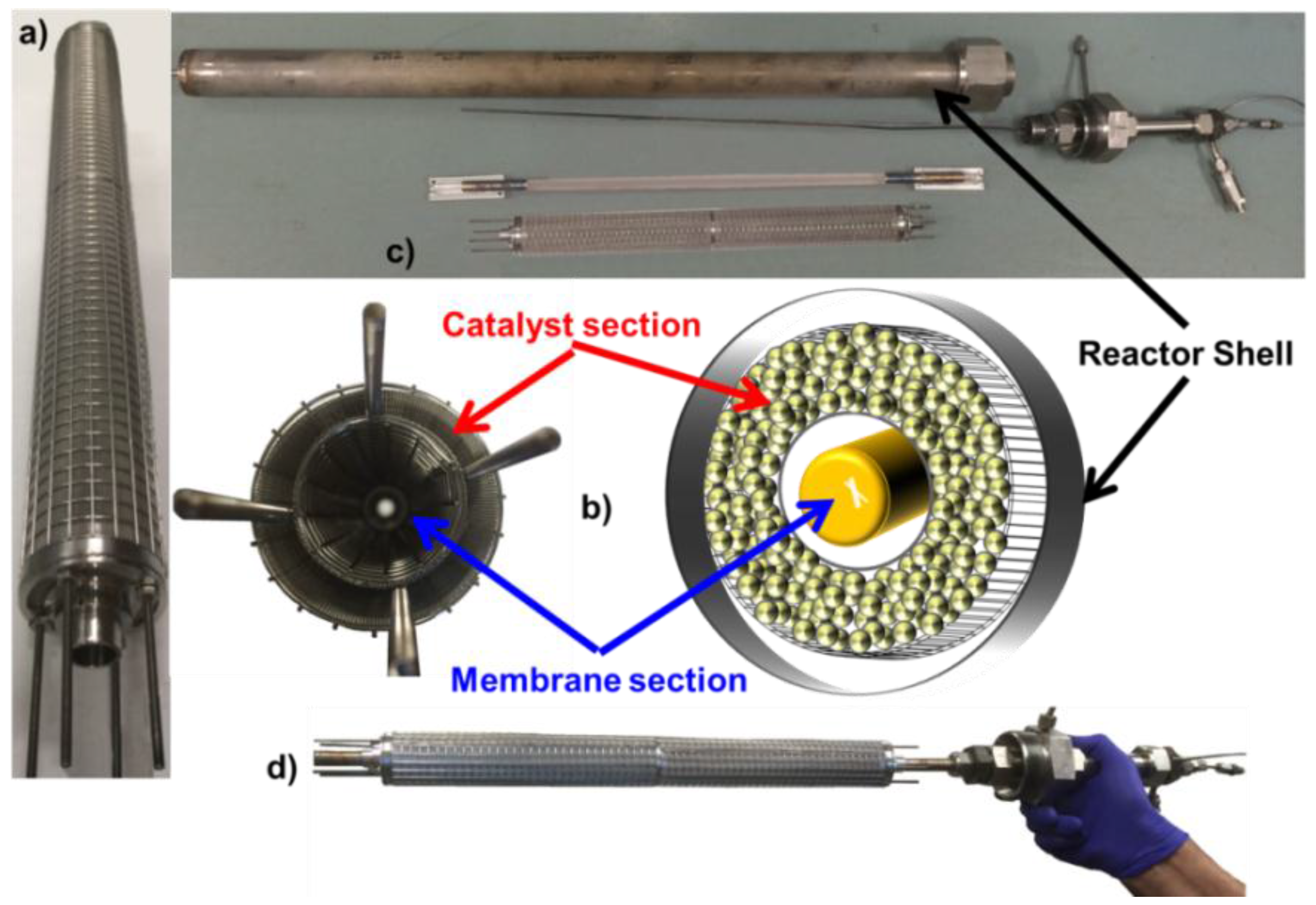
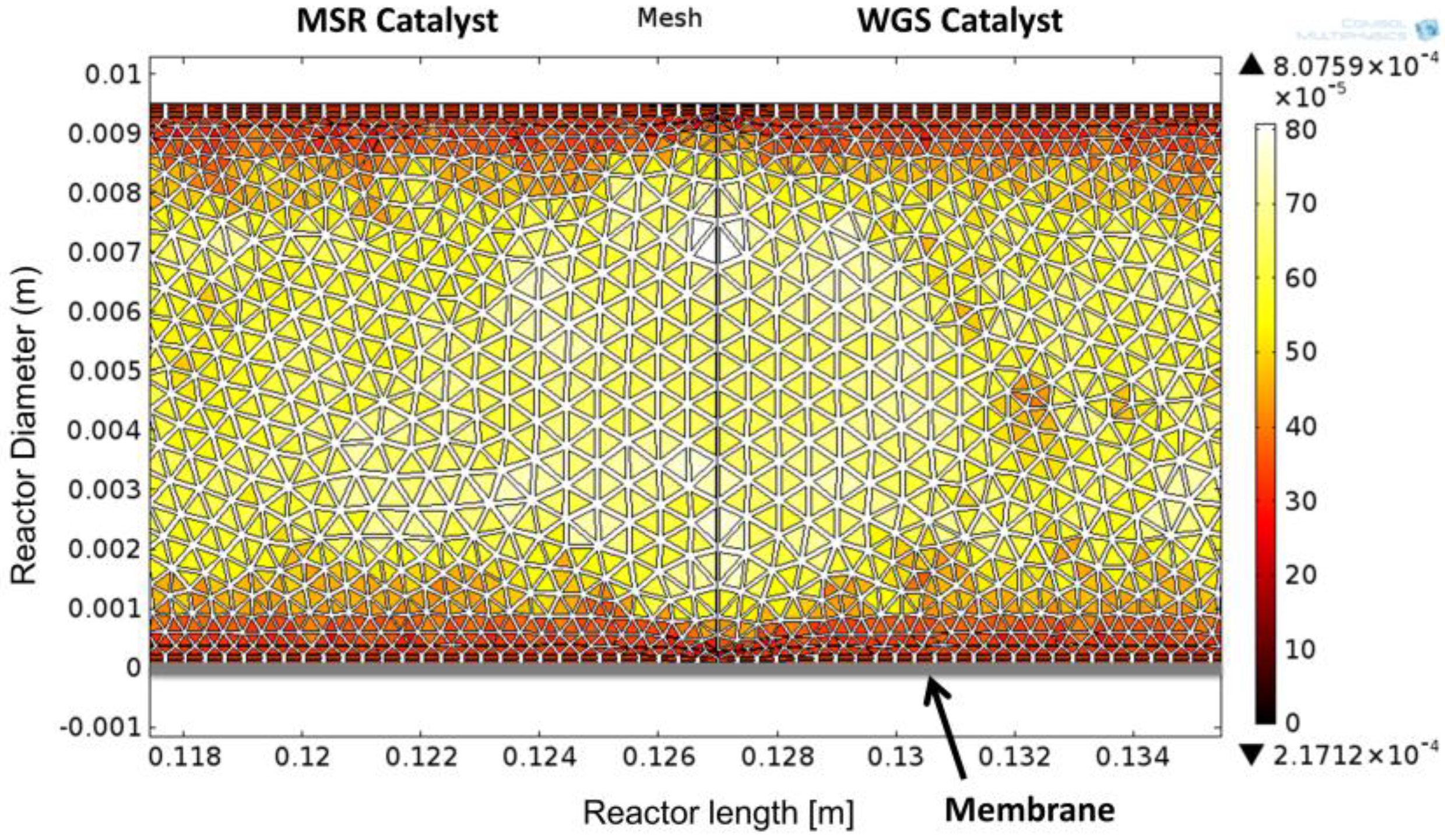
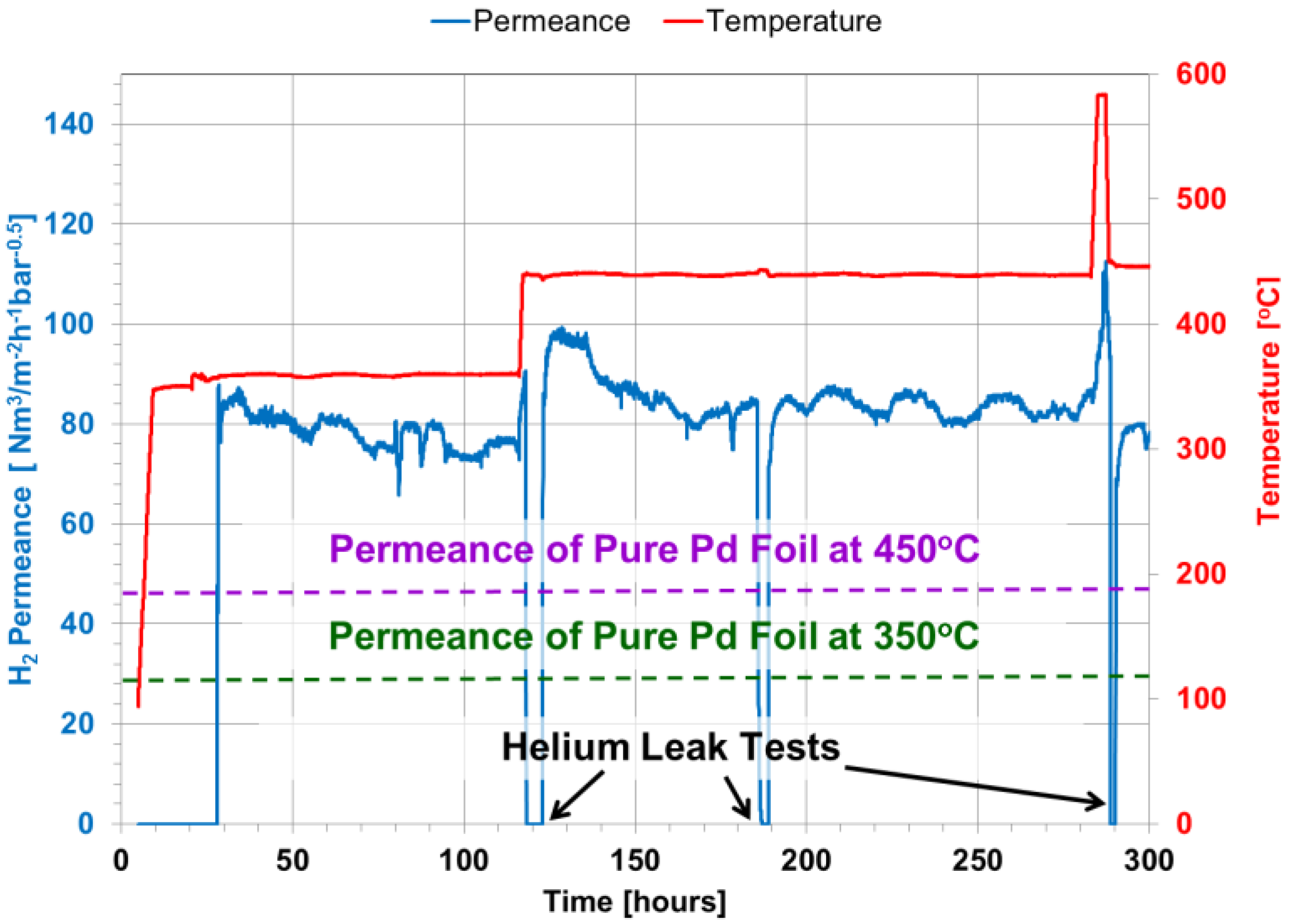
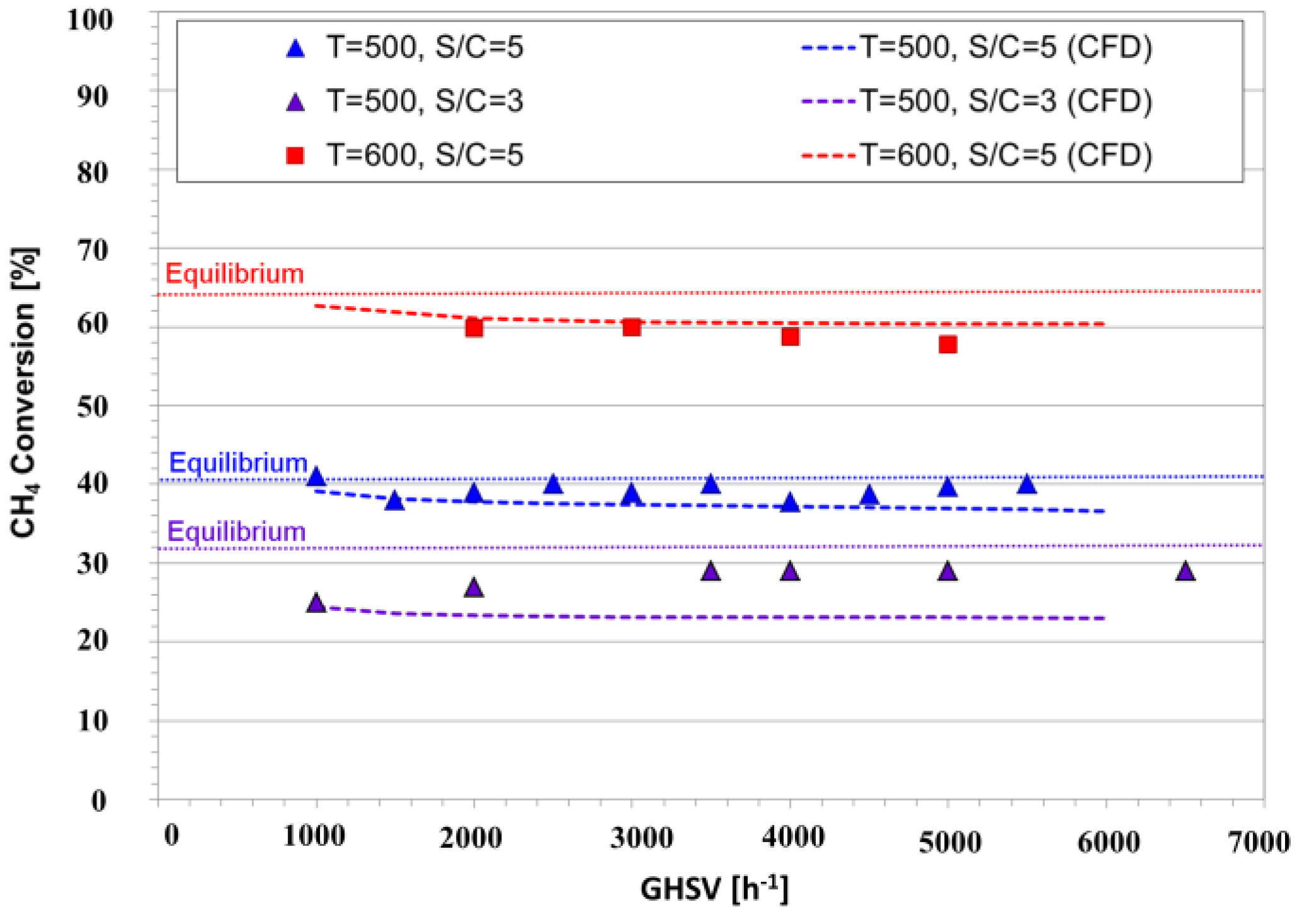

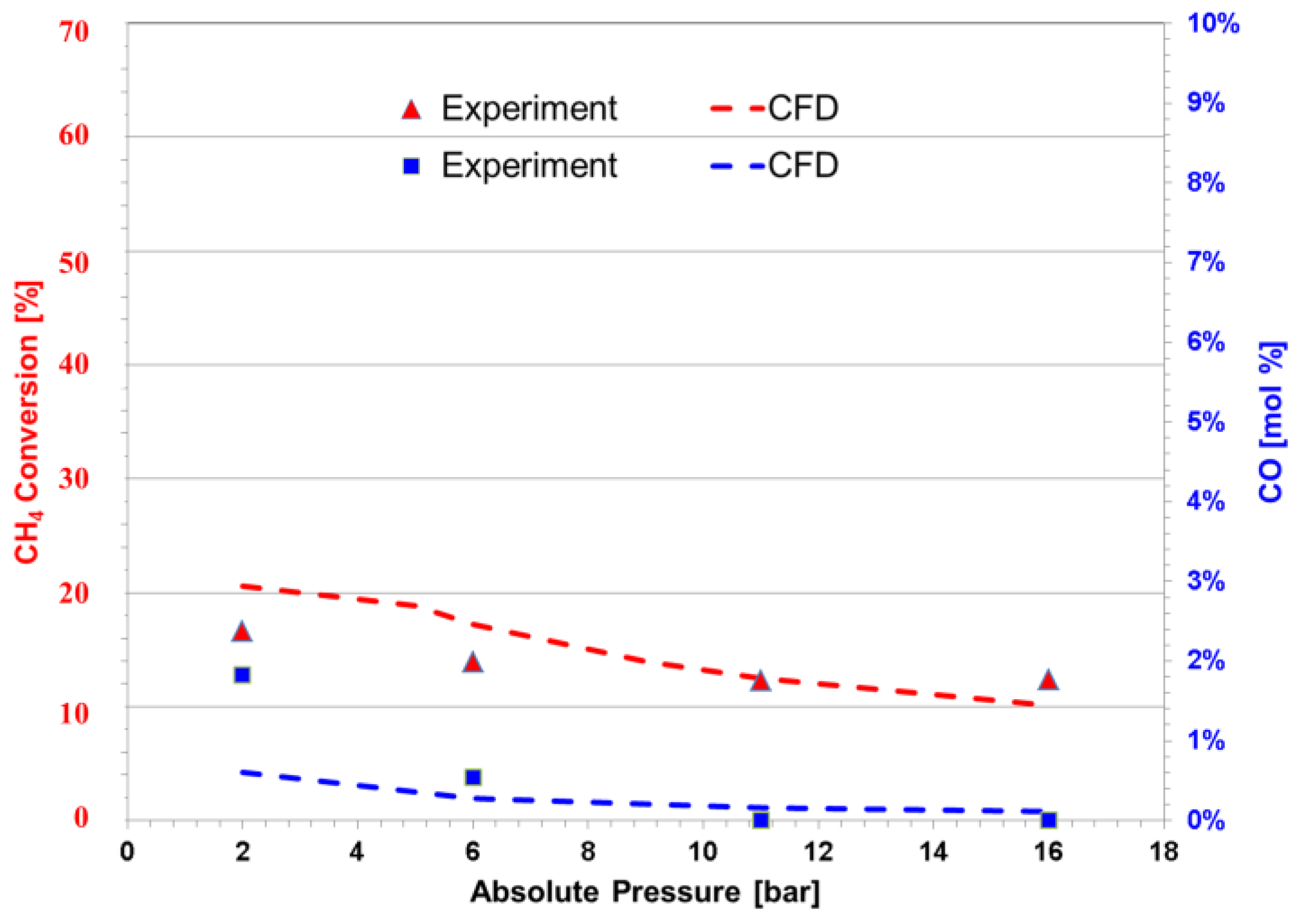
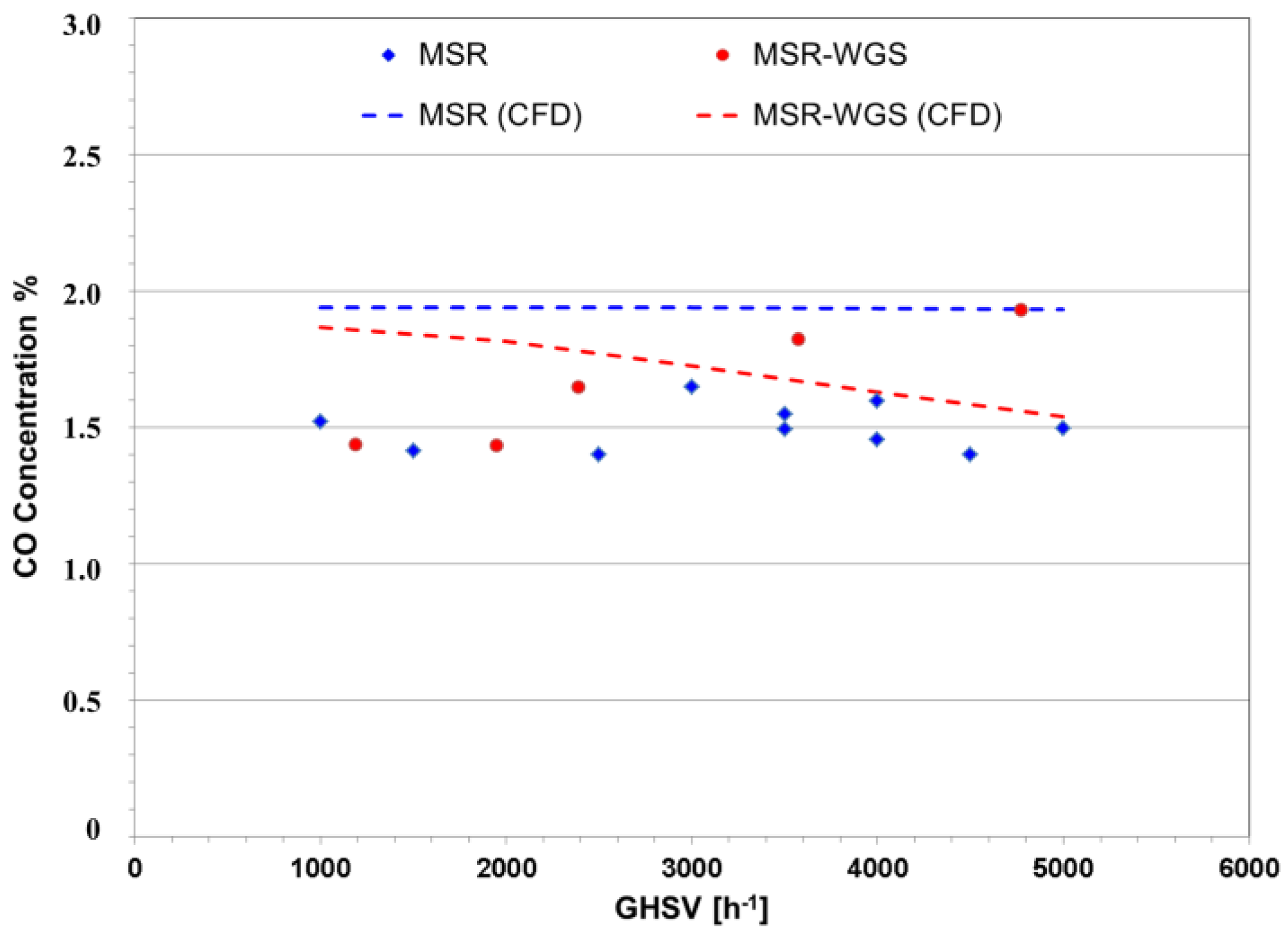

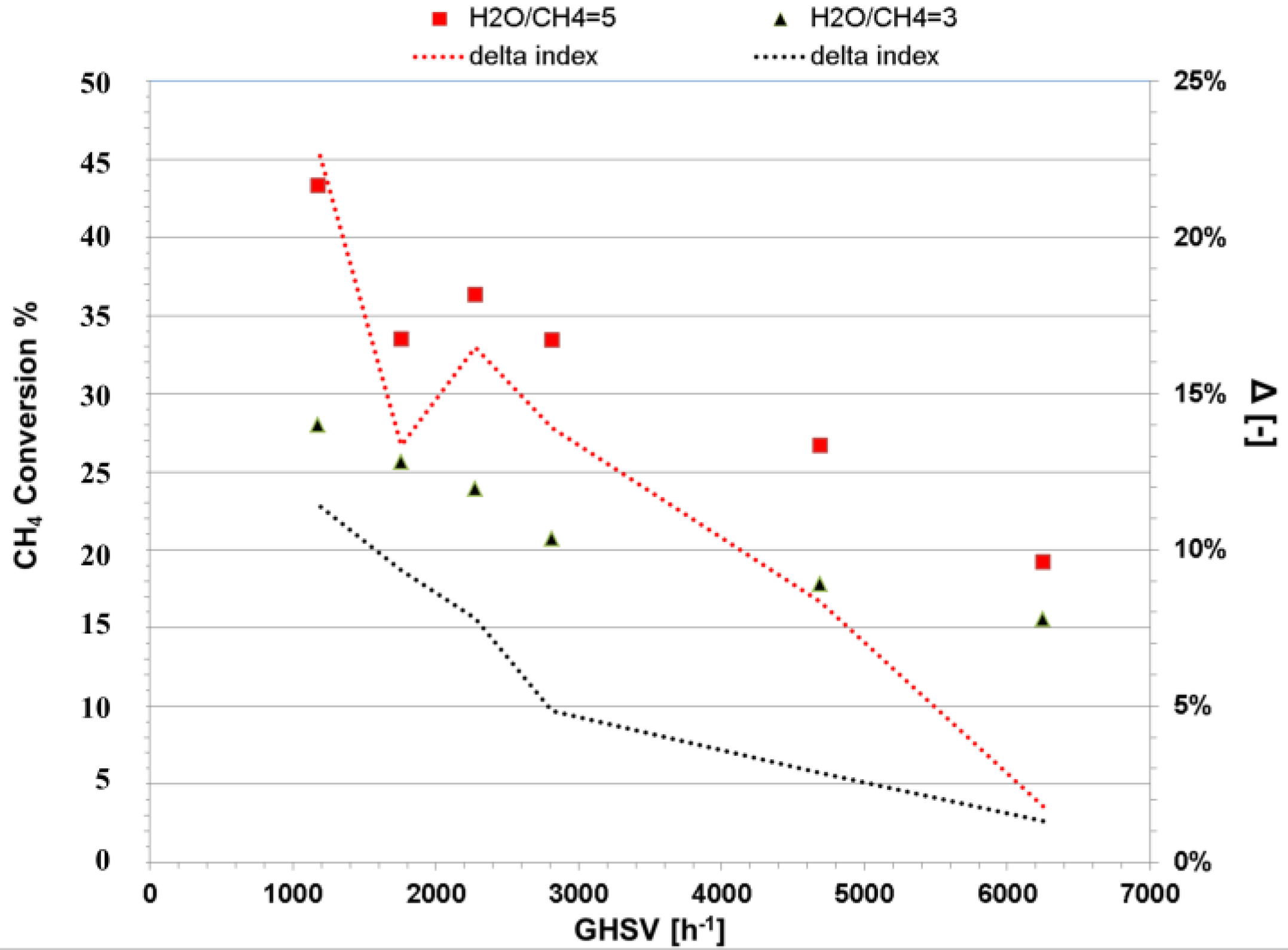
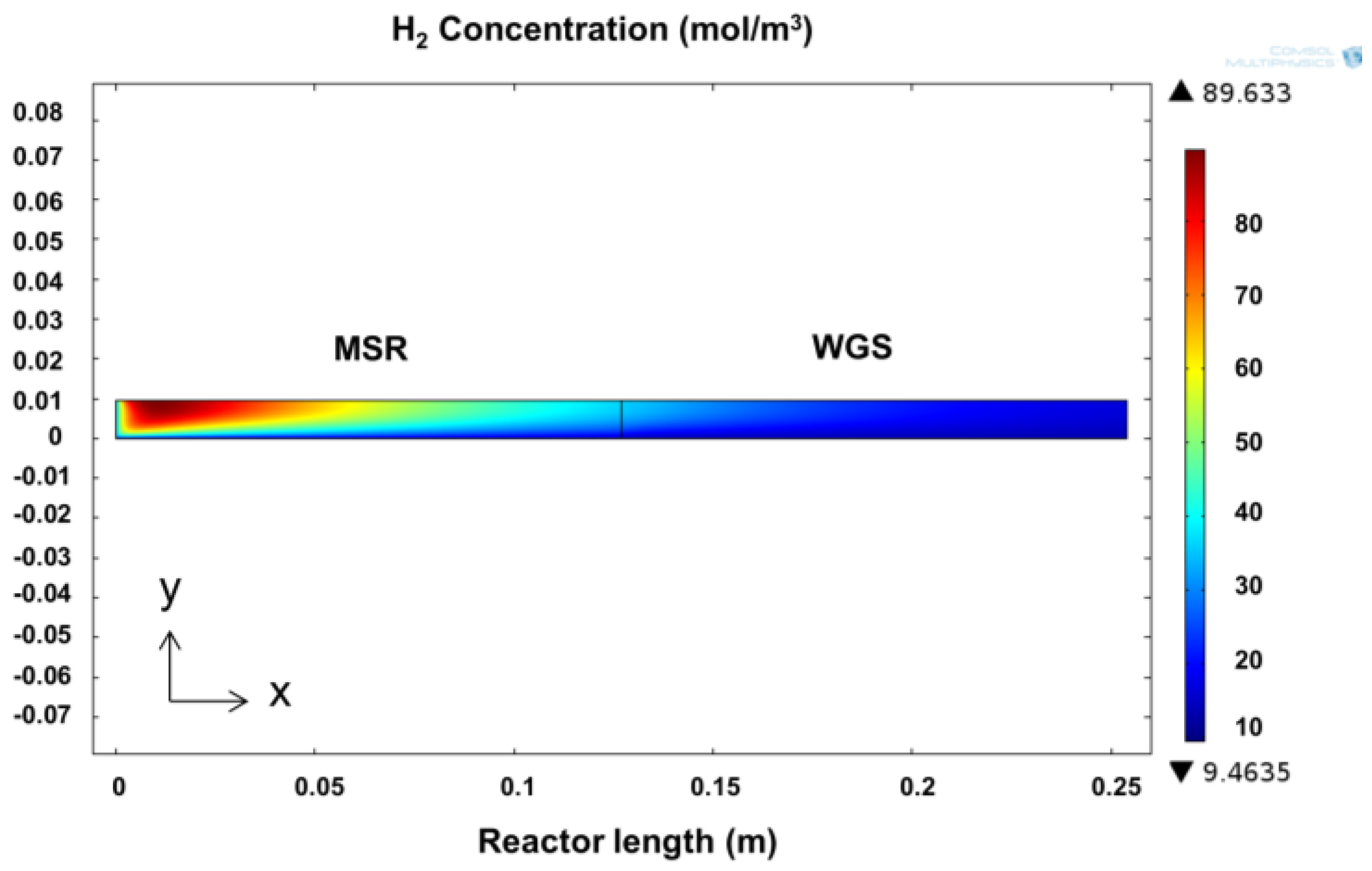
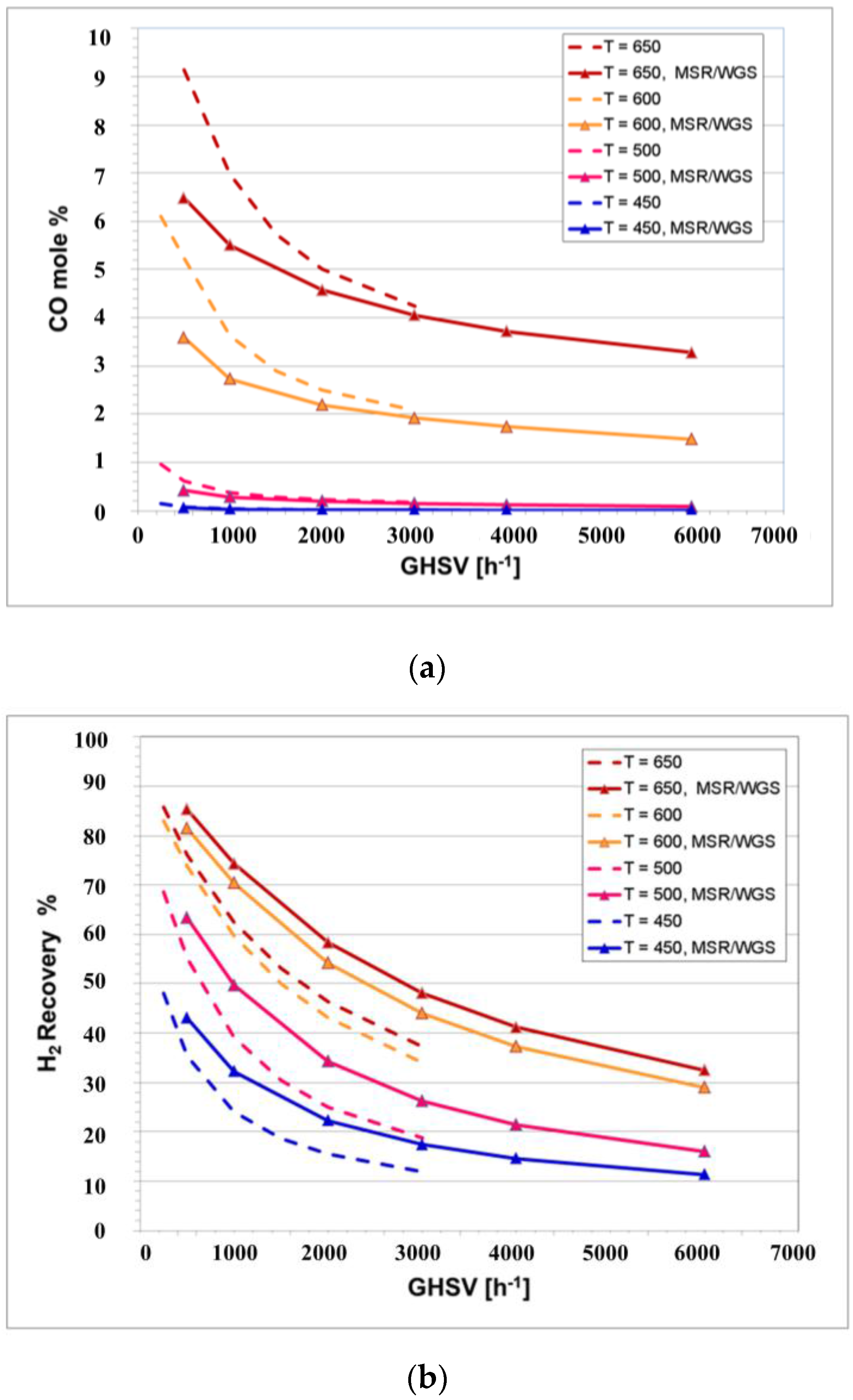
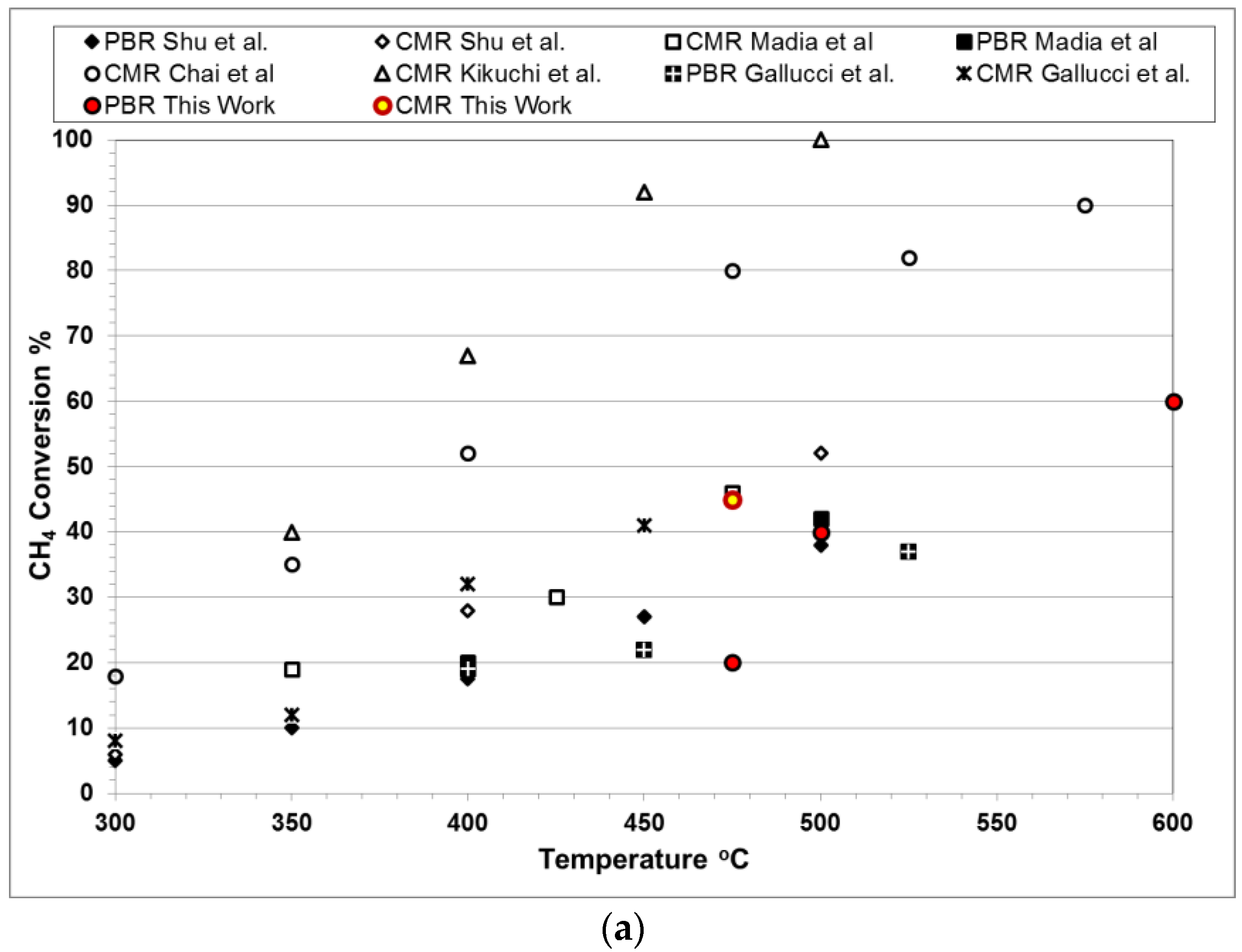
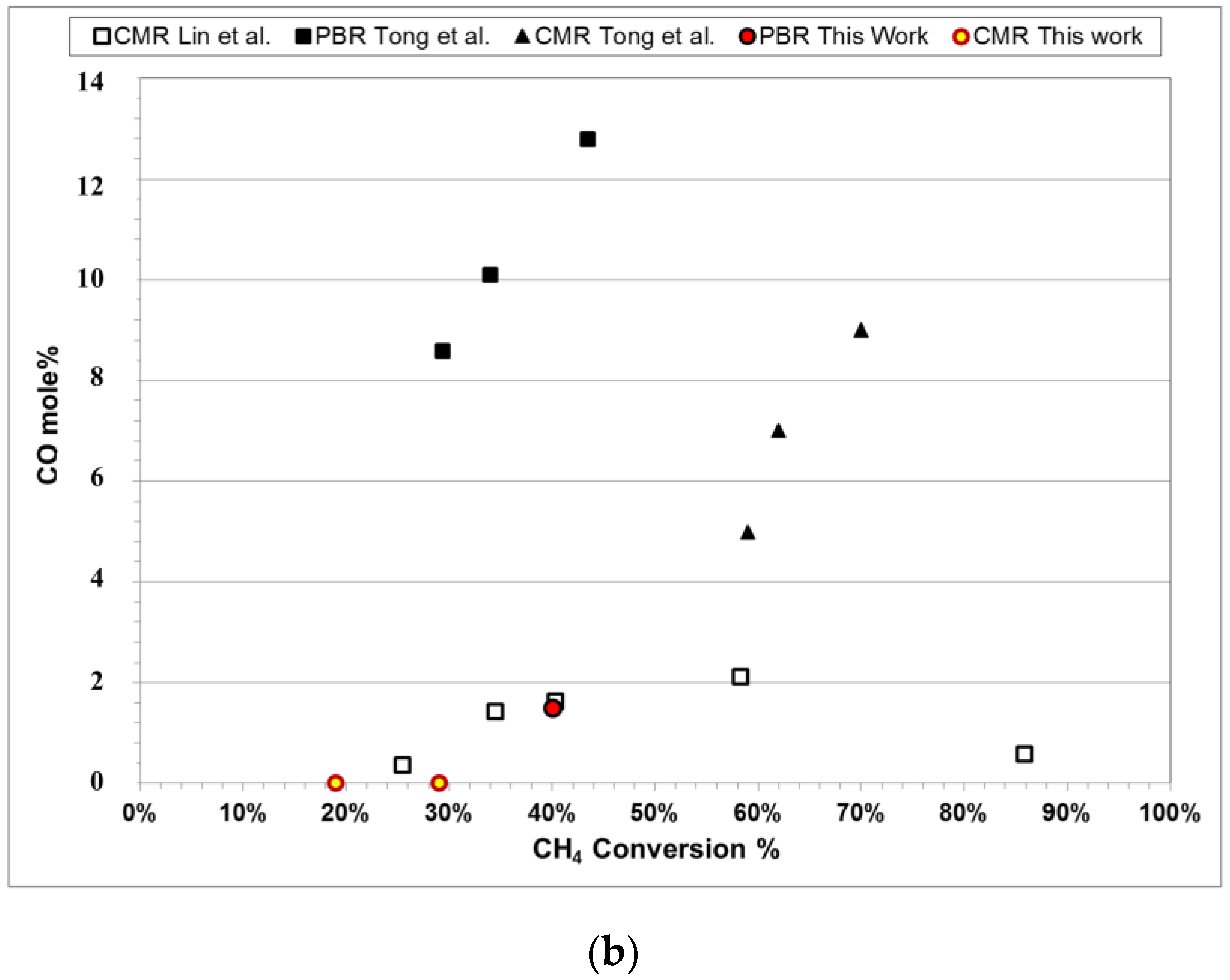
| Membrane Type | Thickness (μm) | Membrane Area (cm2) | Reaction | Pressure (bar) | Steam/Carbon Ratio | Temperature (°C) | Reference |
|---|---|---|---|---|---|---|---|
| Pd/Ag | 50 | 5.3 | MSR | 1.22 | 3–9 | 300–500 | [10] |
| Pd/Ag/PSS * | 10.3 | 10.7 | MSR | 1.36 | 3 | 400–550 | [11] |
| Pd/PSS | 20 | 60 | MSR | 9–20 | 3 | 400–500 | [12] |
| Pd | 4.5–22.5 | 6.3 | MSR | 1 | 3 | 500 | [13] |
| Pd | 4–5 | 175 | MSR | <10 | 2–4 | 525 | [7] |
| Pd/Ag | 200 | 46 | MSR | 1–4 | 2–5 | 300–400 | [14] |
| Pd/Ag | 1000 | 18.5 | MSR | 6–10 | 2.9 | 500 | [15] |
| Pd–Ru/YSZ ** | 5 | 13.28 | MSR | 35 | 3 | 580 | [16] |
| Pd | 20 | 25 | WGS | 3 | 1–5 | 400 | [17] |
| Pd | 1.4 | 21.5 | WGS | 2 | 3 | 350 | [18] |
| Pd-Pd/Ag | 7–10.3 | 50 | WGS | 1–12 | 1.1–2.6 | 350–450 | [19] |
| Pd/Ag | 25–40 | 15.7 | WGS | 1–4 | 7.4 | 200–300 | [20] |
| Pd | 10 | 200 | WGS | 7–20 | 2.5–3.5 | 420–440 | [6] |
| Pd/Ag | 2.2 | 6.8 | WGS | 26 | 5 | 400–450 | [21] |
| Pd/Ag/alumina | 4.5 | 17–35 | WGS | 2 | NA | 400 | [22] |
| Membrane Synthesis Step | Thickness/μm | He Leak (sccm/bar) at 25 °C |
|---|---|---|
| Initial support | NA | 197,360 |
| Oxidation and calcination | NA | 91,830 |
| Grading Pd(Al2O3) | 2.8 | 66 |
| Pd layer | 6.9 | 3 |
| Au deposition | 0.2 | 1.39 |
| Pd layer (final) | 3.17 | NA |
| GHSV (h−1) | DaPe Number |
|---|---|
| 1170 | 0.47 |
| 1750 | 0.61 |
| 2270 | 0.56 |
| 2810 | 0.61 |
| 4680 | 0.77 |
| 6250 | 1.07 |
© 2016 by the authors; licensee MDPI, Basel, Switzerland. This article is an open access article distributed under the terms and conditions of the Creative Commons Attribution (CC-BY) license (http://creativecommons.org/licenses/by/4.0/).
Share and Cite
Castro-Dominguez, B.; Mardilovich, I.P.; Ma, L.-C.; Ma, R.; Dixon, A.G.; Kazantzis, N.K.; Ma, Y.H. Integration of Methane Steam Reforming and Water Gas Shift Reaction in a Pd/Au/Pd-Based Catalytic Membrane Reactor for Process Intensification. Membranes 2016, 6, 44. https://doi.org/10.3390/membranes6030044
Castro-Dominguez B, Mardilovich IP, Ma L-C, Ma R, Dixon AG, Kazantzis NK, Ma YH. Integration of Methane Steam Reforming and Water Gas Shift Reaction in a Pd/Au/Pd-Based Catalytic Membrane Reactor for Process Intensification. Membranes. 2016; 6(3):44. https://doi.org/10.3390/membranes6030044
Chicago/Turabian StyleCastro-Dominguez, Bernardo, Ivan P. Mardilovich, Liang-Chih Ma, Rui Ma, Anthony G. Dixon, Nikolaos K. Kazantzis, and Yi Hua Ma. 2016. "Integration of Methane Steam Reforming and Water Gas Shift Reaction in a Pd/Au/Pd-Based Catalytic Membrane Reactor for Process Intensification" Membranes 6, no. 3: 44. https://doi.org/10.3390/membranes6030044






